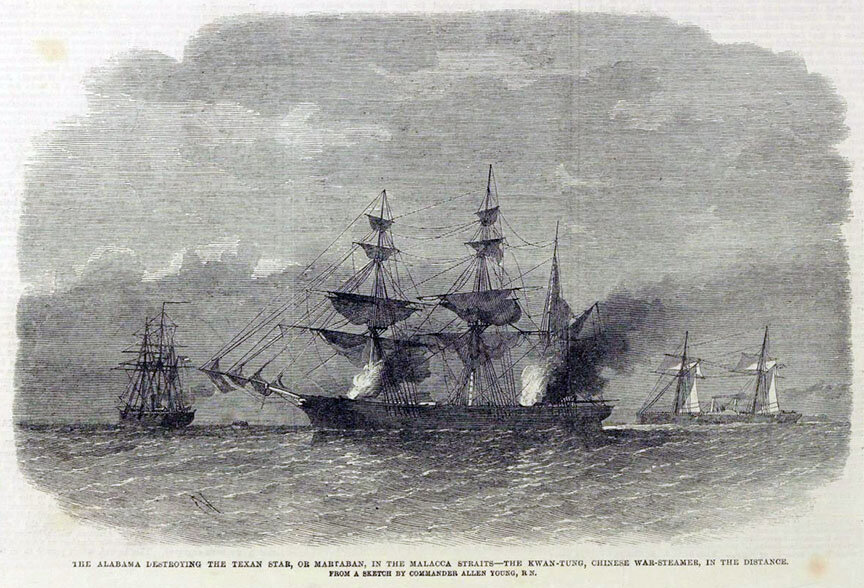
The CSS Alabama destroying the Texan Star (or Martaban) in the Malacca Straits, illustrated in 1864, from a sketch by Commander Allen Young.
December 20, 1863 – January 9, 1863
By Phil Kohn
Phil Kohn can be reached at USCW160@yahoo.com
There is skirmishing at Lagareville, South Carolina, southwest of Charleston, on December 24, 1863.
On Christmas day, December 25, with Union troops converging on him from four directions — from Memphis, Tennessee; Columbus, Kentucky; Nashville, Tennessee; and Corinth, Mississippi — Maj. Gen. Nathan Bedford Forrest successfully pulls out of Jackson, Tennessee, with a large amount of supplies and some 3,500 cavalry recruits and draftees.
On December 26, Forrest and his green cavalry troopers defeat a portion of his Federal pursuers at New Castle, Tennessee. By the end of the month, Forrest has securely set up his headquarters at Holly Springs, Mississippi, about 46 miles southeast of Memphis, Tennessee. Halfway around the world, in the Strait of Malacca that separates the island of Sumatra from Malaya on the western edge of the South China Sea, the Confederate raider CSS Alabama takes two U.S.-flagged vessels as prizes.
In Richmond, Virginia, the Confederate Congress on December 28 abolishes the ability of an individual to have a substitute serve for him in military service.
December 29 sees fighting at Mossy Creek, in western North Carolina. A Federal victory there stabilizes that area for the Union for the rest of the winter.
On December 30, Gov. Zebulon Vance of North Carolina writes a letter to President Davis apprising him of growing discontent regarding the war in his state: “I have concluded that it will perhaps be impossible to remove [the discontent], except by making some effort at negotiation with the enemy.” In Arkansas, a small Federal garrison at Waldron, in the western part of the state, is attacked by Confederates.
In Virginia, on December 31, an article in the Richmond Examiner newspaper reflects the feelings of many throughout the Confederacy: “To-day closes the gloomiest year of our struggle.”
January 1, 1864, finds both armies in winter quarters, with only limited and scattered actions taking place. The weather is bitterly cold in both the North and the South, with temperatures below zero as far south and west as Memphis, Tennessee.
In Dalton, Georgia, on January 2, at a meeting of generals of the Confederate Army of Tennessee, Maj. Gen. Patrick Cleburne — a respected officer whose rearguard leadership allowed the army to escape after being routed at Chattanooga — presents a paper he has written. He proposes recruiting slaves — offering some limited form of emancipation as incentive — to fight in the army to help overcome the Union army’s growing manpower advantage. After an initial stunned silence, there is a very brief discussion, and the idea is soundly rejected. Army commander Gen. Joseph Johnston forbids any further consideration of the topic. One of the other generals at the meeting, however, forwards Cleburne’s paper to President Davis, who — concerned about the uproar the unpopular suggestion will undoubtedly cause — orders that the proposal be suppressed. (Following his suggestion, Cleburne — an immigrant from Ireland — is passed over for promotion three separate times.) In Richmond, Virginia, Gen. Robert E. Lee and Brig. Gen. Robert Hoke, a brigade commander in the Department of North Carolina, present President Davis with a plan for an offensive in eastern North Carolina that would be conducted in coordination with two ironclads — CSS Neuse and CSS Albemarle — that are both nearing completion at separate shipyards in the eastern part of the state.
On January 3, Union cavalry captures Jonesville, in southwestern Virginia.
In Richmond, on January 4, President Davis authorizes Gen. Lee to confiscate food supplies in Virginia for feeding of the army’s troops and livestock during winter quarters. The order does nothing to improve Davis’s flagging popularity with already deprived and discouraged Virginians, who are having difficulty providing food for themselves.
On January 5, Confederate troops return to Jonesville, Virginia, and retake the town, capturing 200 Federal soldiers over the course of the fighting.
In Washington, D.C., on January 7, President Abraham Lincoln commutes the death sentence of a Union soldier convicted of desertion, giving as his reason: “because I am trying to evade the butchering business lately.” The day before, Confederate President Jefferson Davis had similarly commuted a Southern deserter’s death sentence.
Confederate Brig. Gen. John Hunt Morgan, back in Virginia after his escape from the Ohio State Penitentiary (he was captured on a raiding expedition), is the guest of honor at a celebration in Richmond on January 8.
From Richmond, President Davis sends warnings on January 9 to his commanders in Alabama, Georgia and Mississippi that there are reports that Union Adm. Farragut is preparing to attack Mobile, Alabama, with a plan of running past defensive forts as he did in New Orleans in 1862.







